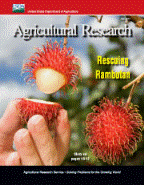United States Department of Agriculture: Agricultural Research Service, Lincoln, Nebraska

Agricultural Research Magazine
Date of this Version
2-2013
Document Type
Article
Citation
Agricultural Research (February 2013).
Abstract
When planning an attack on bothersome pests, it’s a good idea to know your enemies, especially if they happen to be bed bugs. These small, flat, blood-feeding insects—an uncommon problem since the 1950s—have once again become a menace in homes, apartments, hotels, shelters, and even places of work in the last 10 years.
Despite extensive efforts to determine whether bed bugs transmit disease-causing pathogens, no evidence indicates that they are a problem other than their biting, blood feeding, and dirty habits. However, some people have severe reactions to bed bug bites, and getting rid of the insects can be costly. Problems often go unnoticed until bug populations increase substantially.
As part of a strategic plan to control bed bugs, scientists at the ARS Henry A. Wallace Beltsville [Maryland] Agricultural Research Center are learning more about bed bug behavior and stepping up their efforts to develop substances that can be used to control them and other biting arthropods and urban pests.
While the main thrust of the research is to discover and develop new chemicals for bed bug control, entomologist Mark Feldlaufer, chemist Kamlesh Chauhan, and retired ARS entomologist Jeffrey Aldrich also focused on compounds that affect bed bug behavior.
Included in
Agriculture Commons, Animal Sciences Commons, Food Science Commons, Plant Sciences Commons

